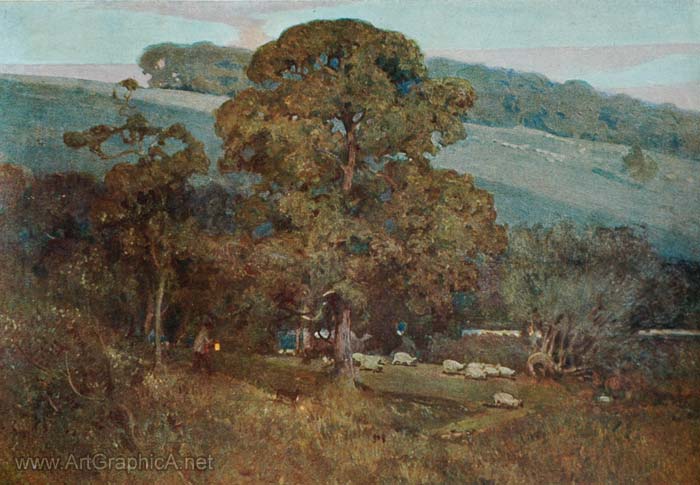Landscape Painting |
||||||||||||||||
|
Page 01 / 14
 Introduction to Landscape PaintingPREFACEIT will be found that I have not attempted in these pages to write at any length on the art of landscape painting in its elementary stages. I have taken it for granted that the reader has, at least, a practical knowledge of the rudiments of drawing, such as may be acquired at any school of art. It is, of course, an absolute necessity that such should be the case before any attempt is made to paint from Nature. My aim, therefore, has been to place before the student certain considerations which do not find a place in the curriculum of our art schools, and which should be of assistance to him in the progress of his development. I am of opinion that the cause of a great many of the failures, amongst those who know something of the technique of painting, is their false attitude towards Nature : no matter how closely they may seek to imitate her, their work lacks the vitality which is always associated with that of a master. Therefore, while I shall not neglect the necessary hints on the technicalities of art, my chief endeavour will be to point out the best method of employing one's knowledge. However well grounded the student may be in technical ability, he may yet be a complete failure as an artist. Beyond the methods of painting there lies the wider problem of the real expression of art. A boy learns at school the conventional rules of arithmetic, and in after life he probably discovers for himself a system of reckoning which is better suited to his purpose; but had he not first learned-the fundamental rules, his own system could not have been so easily evolved. So it is with painting. Technique is of the highest importance. The artist should be able to draw with his brush as easily as a writer uses his pen.  Night in the Cotswolds Assuming then that the student is adequately equipped with technical knowledge, my desire is to present to him ideas and suggestions which will lead him to search for the why and wherefore of things which may have hitherto escaped his attention. Such thoughts and suggestions will, I trust, gradually widen his outlook, give a larger interest to his work, and endow it with qualities which will mark it as a result of honest personal conviction--an expression of his individuality and character. The striving after such an end as this will increase his enthusiasm for his work, quicken his powers of observation, and help him to look beyond mere superficialities. All these qualities are necessary-- to the landscape painter, and in their possession he will find a sure reward. If the student can be induced to study Nature in her broader aspects, and to grasp her higher attributes, which must be present in all art, he will, probably before long, discover the methods by which he can best express what he finds in the world about him. There is a curious belief abroad that art is a trick, a species of cleverness, to which anyone may attain by mere practice and perseverance; that success would be assured if one could only secure the confidence of some eminent painter and learn his secret--his peculiar " trick of the trade." So considerable an amount of unsatisfactory matter has been printed on the subject of landscape painting that it is probable that the student, if he forms any opinion at all, may decide upon a very erroneous one. The fact that landscape painting is such a personal expression, and receives such varied treatment at the hands of its exponents, is partly responsible for this error of judgment. The student, puzzled by so many different methods of expressing Nature, finds considerable difficulty in tracing the underlying principles by which all are governed. For instance, he may look at a Claude or a Poussin, and then at a Turner or a Corot, and find certain principles in the one which appear to be ignored in the other. " I have it on the highest authority," he may reason with himself, " that all these artists are great ; but how can that be ?" In his ignorance he cannot understand that while Claude and Poussin may be right in their precision, Turner and Corot may also be right in their mysterious generalisation. I can imagine such a student discovering in a great picture sonic quality which he takes to be a fundamental principle of art, and in the joy of that discovery he may turn to the work of another master (one of a different school), expecting to find that same quality there. But, alas! he seeks in vain. The principle, as lie thought it to be, is not universal, and in his perplexity he flounders, not knowing where to find a sure basis on which to rest his theories. Ile may examine the method of Turner, which he will find more subtle and elusive than that of Claude. l le may endeavour to discover how it is that that which looks nothing but a daub at close quarters, grows into life and being when seen from a distance. .He may make notes, analyse and copy the pictures, and yet remain altogether ignorant of the great qualities the artist has expressed. The problem grows more and more complex, more and more contradictory, and his mind is in confusion. In trying to judge the work of one artist by a standard which he thought had been established by an equally great artist (and therefore trustworthy) he has come to grief. The masterpieces of musical composition by the exponents of that art are widely different in motif and construction, but they are similar in their adherence to the fundamental principles that govern the art of music. So in like manner the varied expressions of landscape art are reconciled in the principles underlying the works of the masters I have mentioned. There is yet another danger in studying the letter, rather than the spirit of the works of great masters. A student having discovered to his own satisfaction their technical methods, and noted all the peculiarities of their work, may at length find himself looking at Nature through their spectacles. It may seem strange, yet nevertheless it is possible, for a man with a mind so biassed and influenced to approach Nature and see anything in her that he is predisposed to. If he looks for the leaves of a tree carefully arranged in the style of the old masters, he can see them ; he may even go so far as to discover their repetition,' and the peculiarly affected contours of the branches against the sky. 'In short, he may become a slave, and sacrifice his own powers of direct perception to his faith in these formalisms. Eventually he will see Nature entirely through other eyes than his own. But there is one point upon which I would insist--that is, that the conception of the truth and beauty of Nature is not the exclusive possession of one painter, however great he may be. Nature is too boundless in her variations for all her truth to be grasped by one mind. There are aspects that are revealed by Poussin and Claude, and others which elude them, but which Turner and Corot turned to such glorious account. These painters took from Nature just exactly what they wanted for the due expression of their feeling in art. And Nature has some message, some charm, some revelation for each individual, if he has but the eye to see and the hand to record it. Believe me, whatever fault one may find in a work of art, the blame cannot lie with Nature. The greatest errors in landscape painting are to be found--contradictory as it may appear--not so much in the matter of technique as in the painter's attitude towards Nature. If he be a realist, Nature spreads out before him the most wonderful objects, whose beauty is revealed by their faithful delineation. If he be a romanticist, she furnishes again just the special qualities that appeal primarily to his heart. So I would point out to the student the manner in which to study Nature; how to look for what he wants, and at the same time impress upon him the responsibility that lies in the selection of material. As I said before, Nature is so bountiful that the poverty of a man's work can never be 'due to lack of material, but is rather owing to his incapacity to select judiciously from her generous offering. While acknowledging our debt to the past, no true artist will be content to rely unquestionably upon previous authorities, nor allow himself to be unduly biased in his judgment by the influence of their works, however fine. No, it is for every man to work out his own salvation in art, and to be prepared to accept the full responsibility for his work. He must tread his path in a spirit of fearlessness and confidence, yet with humility, assured that Nature is for him and his particular use. Problems there are still to be solved, and he must solve them for himself in accordance with his own ideas. To imitate and to copy is the resort only of the small-minded Man. He may not be fully conscious of his servile attitude towards those he holds in high respect, but his lack of creative power is an evidence of the overbearing influence their work has upon him. The student's aim should be to emulate the great masters in the spirit of their work; to strive after their independence of outlook, and their high standard of craftsmanship. If Nature itself does not suggest to him those higher qualities that are always present in a great work, then the student may rest assured that his vocation in life is not that of a landscape painter. There is no royal road in art. In this department of life, as in every other, the student must serve before he can govern. He must learn to construct, to draw, to paint, to observe, and select. And it is only by close application and increasing perseverance that he can achieve anything worthy. The stamp of personal purpose must manifest itself in order to make his art distinctive-- a purpose that raises his work above that of his fellows in spite of the similar course of training through which they have passed. My object, then, in the following pages, is to help the student to see with his own eyes the things that are essential to his purpose. Nature has so much to offer that her very generosity may prove a snare, since there is a danger of wasting time and labour in the selection of non-essentials; for that which does not help is a positive hindrance. My knowledge of the difficulties that beset the path of landscape painters may enable me to be of sonic service. But of this I am certain, that to those who with patience, with minds free from bias and prejudice, determine to become masters, to them will come the pleasure and the ability of expressing their love of Nature in a language that is perhaps the most beautiful mode of human expression--that of landscape painting. CONTENTS CHAPTER II CHAPTER III CHAPTER IV CHAPTER V CHAPTER VI CHAPTER VII CHAPTER VIII CHAPTER IX CHAPTER X CHAPTER XI CHAPTER XII CHAPTER XIII
Next Page
Prev PagePainting Nature Art Books
|
||||||||||||||||








